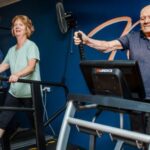Walking and bushwalking are both excellent forms of exercise that offer numerous physical and mental health benefits. Getting out in nature has been shown to improve mental health, cognitive function and reduce stress levels. The choice between bushwalking (hiking) and walking around your local area will depend on a few key factors; with preference obviously coming into play.
Whenever someone is participating in activity, safety is a major concern. Here’s some considerations to safety that we think might be helpful when trying to decide between walking and bushwalking or if you want to get into a bit of bushwalking.
| Walking | Bushwalking |
| Stay Visible: If walking at dawn, dusk, or night, wear reflective clothing and carry a flashlight | Stay on Marked Tracks: Stick to designated tracks to avoid getting lost or injured. |
| Watch for Traffic: When walking near roads, stay alert; watch for cars reversing at driveways, don’t look at your phone (electric cars are VERY quiet) and don’t forget to watch for cyclists. | Check Weather Conditions: Check the weather forecast before heading out and be prepared for changing conditions. |
| Stay Hydrated and Protected: Wear sunscreen and a hat in sunny weather, and drink water regularly to prevent dehydration. | Dress Appropriately: Wear layers and appropriate clothing for the weather, including sturdy hiking shoes or boots. |
| Be Aware of Surroundings: Stay alert to your surroundings and avoid distractions, especially in busy or unfamiliar areas | Stay Hydrated and Fuelled: Always bring plenty of water and additional snacks in case you get stuck somewhere. |
| Buddy System: You may feel safer walking with a small group. | Watch Your Step: Pay attention to your footing, especially on uneven terrain, to avoid slips, trips, and falls (or snakes). |
| Respect Wildlife: Keep a safe distance from wildlife and refrain from feeding or approaching animals. | |
| Leave No Trace: Leave nature as you found it to preserve the environment for others. | |
| Do Not Go Alone: in case of emergency, it is always a better option to go with a small group or at least one other person. | |
| Be Prepared: There is no harm in taking a small first aid kit, better to be safe than sorry!Ensure that the kit has snake bite equipment, band-aids, and space blankets. | |
| In Case of Emergencies: It is recommended that you have the ‘Emergency Plus’ app on your phone. This can be used to contact emergency services and provide your specific location. It is also important to let people know where you are walking and what time you should arrive home. |
It is clear that the risks associated with bushwalking are higher, but don’t let that stop you, it is a great way to be active and explore areas that you have not been to before, you just need a little more planning than a normal walk around the local suburbs. Bushwalking may not be an everyday activity for that reason, but it is a great adventure for a weekend.
From a physical point of view, bushwalks are often longer and over varying terrain. Some time you may have to climb up rocks or walk on slippery surfaces. It is imperative that when you are looking at doing a bush walk that you look at the grade of intensity. It will help you understand if the track is flat, fairly even and may include man made stairs, or if it traverses over rocks, creeks and involves climbing, ideally for the more advanced bushwalker.
The internet is a great way to find walks and generally rates the walk as ‘beginner’, ‘intermediate’ and ‘advanced’. Often you can find information about when the best time of the year to complete the walk and other specific safety considerations (such as tidal information) that may impact the walk. Time frames of walks are also something that need to be considered and catered for.
An Exercise Physiologists Guide to Starting Bushwalking.
1. Walking tolerance: If you wish to start including bushwalking into your exercise regime, you ideally would need to be able walk a similar distance on even ground before attempting a bushwalk of the same distance.
2. Change the terrain: Given the challenges of varying terrain in bushwalking, we would recommend that you train on varying terrain on your local walks, such as soft and hard sand, rocks where possible and even simply on grass, particularly areas where the grass is not as maintained.
3. Challenge your balance: walking on narrow surfaces (close to the ground) or heel to toe walking where you can’t hold on to anything is a good way to challenge yourself. If you feel your balance needs improving then make sure you do not put yourself at any unnecessary risk, you may wish to start your balance training in your hallway or somewhere you can hold on.
4. Strengthening those legs: Strength training can go along way when you are trying to get ready for bushwalking. It can help with stair climbing, balance, muscular tolerance to activity and reduce the risk of injury from over doing it.
5. Most importantly, start small and plan: there are plenty of local bushwalks that are flat, and won’t take a long time. A great place to start is Pucky’s reserve to practice the different surfaces of tracks. Then progress from there.
If you are keen to get even more mental health benefits from your walking then why not try bushwalking. It is a great way to see the local area and engage with nature. The Illawarra has so many wonderful walks to explore, just jump online or ask one of the Body Dynamics team for their favourite Illawarra walk!










